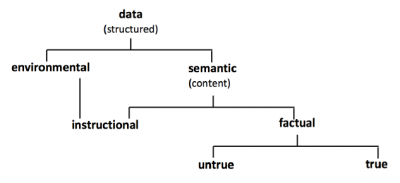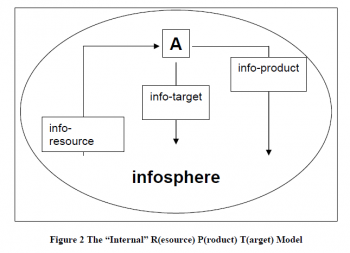Difference between revisions of "Infosphere"
| Line 1: | Line 1: | ||
| − | + | [[File:Floridi_STRUCTURE.png|400px|thumbnail|The Infosphere as Reality, interacting with Space, Time, and Agents<ref>Hector Skinner (2016), '''Presentation on theme: "Luciano Floridi www.philosophyofinformation.net Research Chair in Philosophy of Information UNESCO Chair in Information and Computer Ethics University.'''</ref>]] | |
[[File:Floridi_STRUCTURE.png|400px|thumbnail|Adapted from Floridi, 2010, p29<ref>Floridi (2010), '''The Philosophy of Information: Ten Years Later'''</ref>]] | [[File:Floridi_STRUCTURE.png|400px|thumbnail|Adapted from Floridi, 2010, p29<ref>Floridi (2010), '''The Philosophy of Information: Ten Years Later'''</ref>]] | ||
[[File:FloridiGillfaPicture.JPG|250px|thumbnail|Luciano Floridi]] | [[File:FloridiGillfaPicture.JPG|250px|thumbnail|Luciano Floridi]] | ||
Revision as of 23:15, 15 March 2019


Contents
Definition
The Infosphere is a neologism coined in the seventies, used in the field of Information Ethics to denote a collection of inforgs in addition to their interactions with each other. In its conception by Floridi, the growth of the Infosphere is roughly proportional to the growth of first, second, and third-order technologies interacting with ICTs. Specifically, the growth of the amount of third-order technologies, in addition to the growth of third-order ICT technologies, precipitates the wider array of interactions that further comprise the Infosphere, in its conception by Luciano Floridi. The role of ICT technologies in the Infosphere is to "close the loop" human-machine interaction, by converting a human-machine interaction, into a machine-machine interaction, removing the need for a user. Thus, ICT technologies serve the role of slowly eliminating the "in-between" property that technologies traditionally contain, within the Infosphere. Further, "ICT-friendly" technologies slowly convert a world conceptualized primarily physically, into a world conceptualized primarily informationally. The "in-between" property that Floridi describes, refers to the amount of physical presence that a technology imposes upon a user, in order for the user to achieve their desired application. As a third-order technology removes the need for a user-machine interaction, the relation between third-order technologies and ICT technology is one in which the user is able to achieve efficiency in their desired application, thus allowing for more "user-friendly" interfaces, through minimizing the "in-between" property of a particular technology.
Origin
Luciano Floridi published "Philosophy and Computing: An introduction" [3] in 1999, defining the Infosphere as "the whole informational environment constituted by all informational entities (thus including informational agents as well), their properties, interactions, processes and mutual relations" For example, in the Preface of Philosophy and Computing, published in 1999, he wrote that the book was meant for philosophy students who need IT literacy to use computers efficiently or indispensable background knowledge for the critical understanding of our digital age. The latter provides a basis for the would-be branch of philosophy, the philosophy of information. PI, or PCI (Philosophy of Computing and Information), became his major research interest.
Resource-Product-Target Model
The Resource-Product-Target (RPT) Model was proposed in Luciano Floridi's book "The Ethics of Information", [4], as an interpretation of ethics as microethics. The purpose of the model is to conceptualize information in an ontological conception, instead of a epistemological conception, where an agent is viewed as "embodied and embedded", as an "informational agent," within an "informational environment." Through the lens of Wikipedia in the context of information ethics, Wikipedia acts as a source for the study of moral issues, which demonstrates the Information as Resource phenomenon. In addition, Wikipedia acts as a product, in the sense where collaborative action yields the product of the information available on the platform. Finally Wikipedia acts as a Target, in the sense in which the integrity, quality, and value of the information can either be damaged or upheld. [5] In Figure 2, note how information flows to, and from arbitrary Agent A, within the RPT Model.
Infosphere Ethics
Floridi Article
Activisim
Helen Nissenbaum marginalized black communities
Comedy and Pop Culture
Futurama
Security and Surveillance
Our right to our unrevealed information (David Shoemaker) is a domain in which, when encroached upon, is a violation of our autonomy, and is further, a violation of self-determination. With social media accounts generating insights from your data that you may not want revealed to these companies, along with Data Brokers gaining access to unrevealed personal information, we can view the informational friction (Luciano Floridi) as decreasing, given that the difficulty to access such information has decreased for agents like these companies. Helen Nissenbaum expands on this, highlighting the problem of false positives in airport security in Israel, where machine reading of emotions through blood pressure, sweat, and changes in voice are analyzed and used to assign passengers with a "threat category" score. The problem with this kind of discourse is the reflexive reasoning that a violation of autonomy can only be curbed with further violation of autonomy on large scales.
See Also
References
- David Shoemaker Self-exposure and exposure of the self: informational privacy and the presentation of identity
- Luciano Floridi - Privacy-Informational Friction 2014
- David Gelernter - The Second Coming, A Manifesto 2000
- Helen Nissenbaum - Privacy in Context: Technology, Policy, and the Integrity of Social Life

